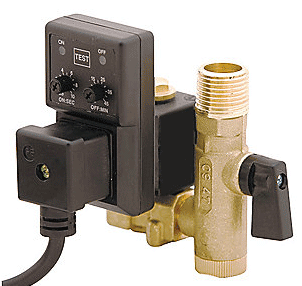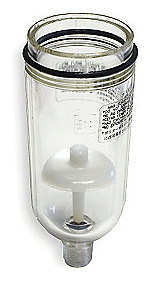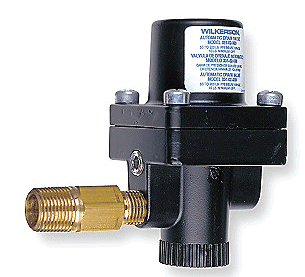In terms of keeping your air compressor running optimally, we think compressor auto drains can be a positive factor.
For example, do you drain your air compressor tank regularly – preferably after every use of the air compressor? If you have a spare compressor air tank in the circuit, is it drained regularly. If you have compressed air filters in your air supply to your air tools, do you empty the filter bowl regularly?
The reality for most of us is that compressor auto drains, installed where practical and applicable, would answer all the the questions with a “yes”. The absence of them means most of us answer these questions with a “no”.
What are compressor auto drains?
One type of an auto drain is a valve that operates regularly and periodically, opening for a specified length of time on a predetermined basis, and uses electricity to provide the power and the timing function. One of these is shown below. One source for this type of auto drain is Grainger. You can see the power supply and the two adjustment knobs. One of these adjusts the frequency of valve operation, and the other adjusts the length of time that the valve opens each time the timer turns on the power. This model has a manual ball valve installed as well, which is sometimes useful as an override.

Another is a simple float-type which responds to the rising level of water in a vessel, opening briefly as the water level lifts the float high enough to open a line to the exterior, and when the water level drops, the float does as well, and seals up the drain hole. One of those, supplied by Grainger, is shown in this next photo.

Some compressor auto drain valves can be operated by an air signal. A programmable logic device would have a program built in that would open and air valve and send an air signal to the air-operated drain valve on a timed basis to void water from anywhere in the compressed air circuit the device was installed. One of these, made by Wilkerson and sold by Grainger is shown below.

Why have a compressor auto drain?
The compressing of air generates quite a bit of free water.
This water ends up pooling in the bottom of your compressor air tank. It sometimes gets picked up by compressed air in the tank and is flung into your air lines as you use your air tools. Flowing compressed air in the air lines cools, and as the air cools, water condenses out.
Depending on how much compressed air you use and the length of air lines you have to get air from the compressor tank to your application, you may end up with a lot of water in your air and reaching your air tools and other air using appliances. In most cases, these air tools and air using appliances do not fare well when flooded with water.
The strategic use of compressor auto drains – one in the drain port of every tank or air reservoir, and one at every drop leg where compressed air is plumbed down to the air tool, will go a long way in ridding your air system of water.
Frequent and thorough draining of the air tank helps maintain the integrity of the air tank as well, since regular draining keeps the tank dry, helping to eliminate rust over the long haul.
If you have a question about compressor auto drains of any sort, feel free to use the comment box below to ask it.

Hello.
I have a small compressor for my brad nailer for DIY woodwork. I release the pressure after every time I use it. Do I need to get an aftermarket auto drain for it? I’m just concerned that the rubber grommet on the valve will get quickly worn if I keep on opening and closing the valve. Thank you.
Can you advise why a TVR-G-15 Titan Valve would blow solonoid out
Gary, interesting shot. Am I interpreting it correctly in that the parts on the floor to the left were sitting on the valve attached to the tank drain?
Man, that’s an odd one. Anything unusual in the compressor intake air that might be getting into the tank and weakening the solenoid housing?
Hi Sir,
I am Denny, I would like to ask you regarding any possible root cause that will cause auto drain kit broke.
Recently we are having issue on our auto drain kit. it broke after 2 months of installation. attached is the picture.
Based on your expertise, may I know what will be the causes of these breakdown?
Regard
Denny
Hello Denny. Love to try and help but no photo is here that I can see, and I have no idea what kind of auto drain, where on the compressor it’s installed, or how it broke. Sorry.
Hi Sir,
Point 1 – We are having Unloading pressure 10 Bar Capacity compressor at our site.
Point 2 – Inbuilt auto drain valve came along with the compressor.
Point 3 – Even Though auto drain valve came inbuilt, we are facing the water mix with air.
Point 4 – once shift completed we use to open the tank bottom drain valve every day. shift Hr 8 Hrs.
Point 5 – We thought that drier is not working properly. For the reason we cross checked the Drier service engineer as well. The service engineer told that drier is working fine.
Point 6 – Even we checked the auto drain valve function also, it’s working fine.
Note – My concern is that why we should not set the Auto drain valve at the bottom of the tank. If i fix the Auto Drain Valve at Bottom of the tank there will be any issue will come.
If so give some suggestion to short out the problem.
An properly installed and working compressor tank auto drain will drain the tank if liquid water on a regular, timed basis. This is important to help water in the tank to not be re-en trained in the air stream out of the tank. An auto drain will not dry the air. It will only drain the tank, and help keep free water out of the air stream.
The drier is to dry the air. If the air drier is working properly, what is the dew point of the air when it leaves the drier? Is the temperature in the plant close to that dew point?
What is the distance from the compressor tank to where air is being used? Air cools in the lines as it travels, and if the distance is long enough, it is possible that water vapor in the air is condensing out in the lines. Consider a water trap at the point of use.
Hi
We have a new system being installed in a power plant. There is auto drains being fitted to the compressor tanks but there are no drains fitted after.
Is there a guide to how many drains or auto drains should be fitted to a system?
Good question. In my opinion, any application for compressed air that can be negatively affected by water in the air, needs a water filter and auto drain. Water filters come with all sorts of drains, and the installer needs to know what type is on the filter. Failure to add a proper drain may mean that the filter bowl, and the downstream application, could see a steady stream of water once the bowl fills.
if the auto drain is not working,it is possible not to start the compressor or it can affect to prevent starting the compressors?
I moved your question to the Compressor Auto Drains page. Are you talking about an auto drain on the compressor tank, or an auto drain on a compressed air filter, or one somewhere else in the air circuit? Since the auto drains purpose is to allow automatic voiding of water buildup, pretty much regardless of where the drain is installed in the circuit or on the compressor, I can’t see how it not working has much or any effect on the startup of the air compressor. The two are not normally connected. If I’ve misunderstood the question, please add details.
hi
what is the procedure to make maintenance for the auto drain ?
To have it cycle regularly and frequently enough to ensure that any tank water is voided. If, in the fullness of use, the tank drain will not shut securely, it is likely that debris is preventing that from happening, and the tank drain needs to be removed and cleaned or replaced. If the tank auto train will not open, it is possible the solenoid operator has failed, in which case, replacing it may be your only option.
In the following system, a 1 HP or 3.10 A (40L/min) air-compressor will be switched on by an electric timer, once every 2 hours or so (4 minutes at a time).
This requires an Auto-Drain valve that opens it’s valve for about 0.5 sec ? after the compressor has been running for 1 min.
Are there Auto-Drain valves that function this way?
We have a hard time visualizing the application and why there is the need for a 0.5 second auto drain?
However, is there an auto drain off the shelf that will do this? Doubt it.
Instead, install a 2/2 NC valve in the drain line from the tank, and leave the manual drain open all the time. Send an electrical signal from a PLC to the solenoid valve in the drain line to open it for the 0.5 seconds, or whatever duration required when it is necessary to drain the tank for that time frame.
Question: I have an IG 10 horsepower. It has an automatic electric water valve, and it is constantly running. This of course leads to low flow problems in the shop. Any ideas on how to trouble shoot the valve?
Hello David. Well, we have to tell you that we don’t recognize the brand that a IG10 HP compressor is? Also, if when you refer to an automatic electric water valve, are you referring to an auto drain for the compressor tank? If so, is the constantly running issue a new one, or has it been going on a long time.
Even though auto drains are opened and closed electronically, they are still valves, and if debris from the tank prevents the valve from closing fully when it’s supposed to, the drain will leak even though it’s turned off. With an empty tank and the compressor off, pull the auto drain and inspect the bleed port carefully to see if it’s got crud in it.
One other issue. The operators on these types of drains usually have two settings. One is for how frequently the valve cycles open and closed… every 5 minutes for example. The other setting is for how long the valve stays open when it operates on the cycle. If someone has mucked with these two settings, it is possible that the drain has been set to stay open, and an adjustment of the settings might resolve this.